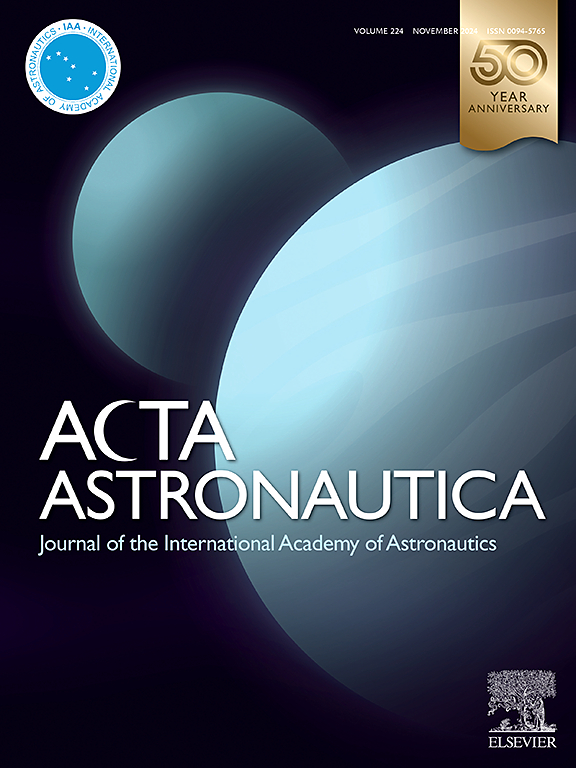高温氧化铝液滴与炭层碰撞特性研究
IF 3.1
2区 物理与天体物理
Q1 ENGINEERING, AEROSPACE
引用次数: 0
摘要
固体火箭发动机中高温氧化铝液滴与炭层的碰撞特性对熔渣沉积和流场模拟的准确性具有重要意义,但目前对氧化铝液滴与炭层碰撞特性的研究仍处于空白状态。本研究基于高温成型法制备炭层,并将其孔隙率与固体火箭发动机中的炭层孔隙率进行对比,表明二者结构较为相似,可应用于液滴碰撞实验。利用高温氧化铝液滴冲击实验系统对氧化铝液滴与炭层的碰撞进行了实验研究。实验结果表明,氧化铝液滴的粘附行为与炭层的粗糙结构和液滴撞击炭层过程中的高粘度耗散有关,液滴在回缩阶段以剧烈振荡的方式粘附。由于高表面张力和壁面粗糙度的针刺效应,液滴在壁面上的反弹行为表现为 "拖尾"、"旋转 "和 "非对称反弹 "现象。绘制了液滴撞击炭层的反弹/粘附结果体系图。在相同速度下,粒径较小的液滴更容易粘附在炭层上。我们建立了反弹和粘附行为之间的关系。根据实验结果,建立了液滴最大扩散因子的关系,为深入理解和研究固体火箭发动机中的液滴碰撞过程提供了理论依据。本文章由计算机程序翻译,如有差异,请以英文原文为准。
Study on the collision characteristics between high-temperature alumina droplets and char layer
The collision characteristics between high-temperature alumina droplets and the char layer in solid rocket motors are of great significance for the accuracy of slag deposition and flow-field simulations, however, the current research on the collision characteristics of the alumina droplets and char layer is still in a blank state. This study is based on the high-temperature molding method to prepare the char layer and compare the porosity with that of the char layer in solid rocket motors, indicating that the two are relatively similar in structure and can be applied to droplet impact experiments. An experimental study on the collision of alumina droplet with the char layer was conducted using a high-temperature alumina droplet impact experimental system. The experimental results show that the adhesion behavior of alumina droplets is related to the rough structure of the char layer and the high viscosity dissipation of the process of droplets impacting the char layer, and the droplets adhere during the retraction stage with violent oscillation. The rebound behavior of the droplets on the wall was characterized by “tail dragging”, “spinning” and “asymmetric rebound” phenomena due to the combination of high surface tension and the pinning effect of wall roughness. A regime map of the rebound/adhesion results of droplets impact the char layers was constructed. At the same speed, droplets with smaller particle sizes are more likely to adhere to the char layer. We established a relationship between the rebound and adhesion behavior. Based on the experimental results, the relationship for the maximum spreading factor of the droplets was established, providing a theoretical basis for the in-depth understanding and study of the droplet collision process in solid rocket motors.
求助全文
通过发布文献求助,成功后即可免费获取论文全文。
去求助
来源期刊

Acta Astronautica
工程技术-工程:宇航
CiteScore
7.20
自引率
22.90%
发文量
599
审稿时长
53 days
期刊介绍:
Acta Astronautica is sponsored by the International Academy of Astronautics. Content is based on original contributions in all fields of basic, engineering, life and social space sciences and of space technology related to:
The peaceful scientific exploration of space,
Its exploitation for human welfare and progress,
Conception, design, development and operation of space-borne and Earth-based systems,
In addition to regular issues, the journal publishes selected proceedings of the annual International Astronautical Congress (IAC), transactions of the IAA and special issues on topics of current interest, such as microgravity, space station technology, geostationary orbits, and space economics. Other subject areas include satellite technology, space transportation and communications, space energy, power and propulsion, astrodynamics, extraterrestrial intelligence and Earth observations.
 求助内容:
求助内容: 应助结果提醒方式:
应助结果提醒方式:


